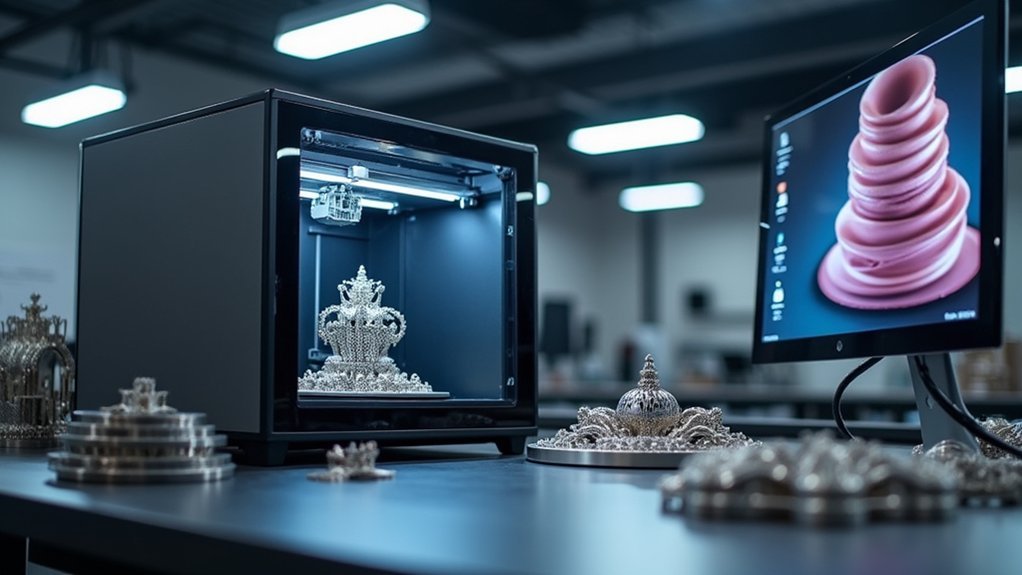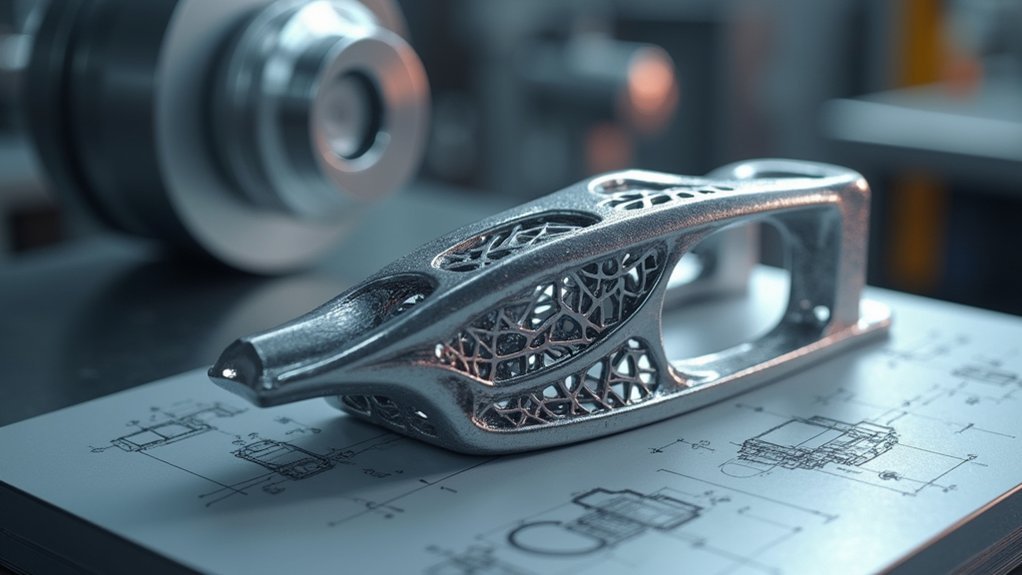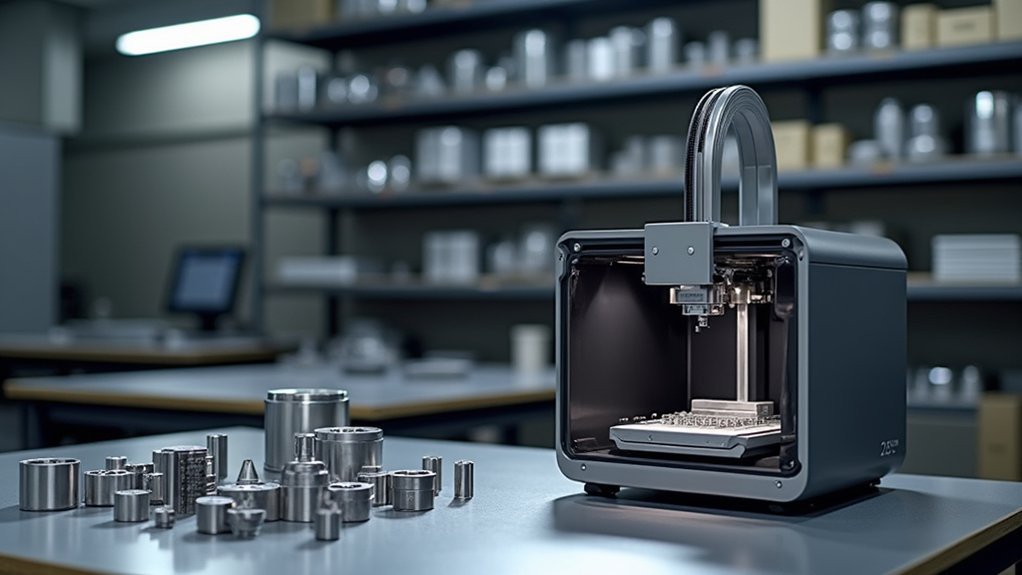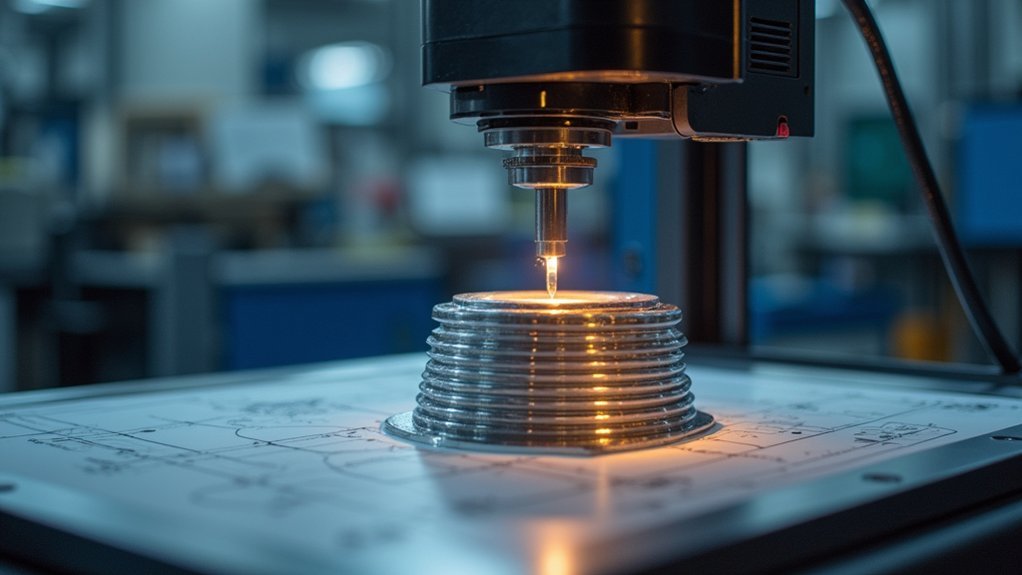You’ll choose metal 3D printing for industrial applications because it eliminates expensive tooling requirements, accelerates product development from weeks to hours, and manufactures complex geometries impossible with traditional methods. You can consolidate multiple components into single assemblies, reduce material waste through precise layering, and create lightweight yet high-strength parts for aerospace, automotive, and medical sectors. This technology delivers superior mechanical performance while offering unlimited design freedom and customization capabilities that transform your manufacturing approach entirely.
Accelerated Product Development and Time to Market

When traditional manufacturing methods require weeks or months to produce functional prototypes, metal 3D printing transforms your product development timeline by delivering parts directly from CAD designs in just hours.
Metal 3D printing delivers functional prototypes in hours, not weeks, revolutionizing your product development speed and competitive advantage.
This accelerated product development process enables rapid prototyping that dramatically shortens your time to market, giving you a competitive edge in fast-moving industries.
You’ll eliminate custom tooling requirements, reducing both upfront costs and lead times considerably.
The technology provides a cost-effective way to produce functional parts for immediate testing and refinement.
Through faster iteration cycles, you can enhance product quality while streamlining workflows with on-demand production capabilities.
This acceleration translates directly into increased revenue potential and market advantages for your business.
Complex Geometry Manufacturing Without Traditional Constraints
You can now manufacture parts with intricate internal channels that would be impossible to create using traditional machining or casting methods.
Metal 3D printing’s generative design capabilities let you optimize structures for performance while exploring complex geometries that conventional manufacturing simply can’t achieve.
You’ll also consolidate multiple components into single, complex assemblies, eliminating the need for separate parts and joining processes.
Intricate Internal Channels
Since traditional manufacturing methods rely on external tooling access, they can’t create the complex geometries that metal 3D printing produces with ease.
You’ll discover that internal channels can now be fabricated with unprecedented intricacy, enabling advanced cooling systems and optimized fluid flow that weren’t previously achievable.
This technology eliminates the need for custom tooling, dramatically reducing your overhead costs and lead times.
You can incorporate sophisticated internal channel designs without increasing production expenses, making advanced features accessible for your projects.
These internal cavities enhance part performance through significant weight reduction and improved material efficiency.
You’ll benefit from generative design approaches that optimize internal configurations, creating components that maximize performance while minimizing weight—perfect for demanding aerospace and automotive applications where every gram matters.
Generative Design Capabilities
Metal 3D printing’s ability to fabricate intricate internal features extends far beyond simple channels—it releases generative design capabilities that fundamentally transform how you approach complex geometry manufacturing.
You can leverage algorithms to explore thousands of design possibilities, creating generatively designed structures that optimize performance while meeting specific criteria. Metal additive manufacturing eliminates traditional tooling constraints, allowing you to focus purely on form and function without worrying about machining limitations.
These capabilities let you produce complex parts with internal lattice structures, cooling channels, and optimized geometries in single builds.
You’ll accelerate product development by simplifying assemblies and reducing component counts. This freedom fosters innovation within your organization, enabling designs that were previously impossible with conventional manufacturing methods.
Consolidated Part Assembly
When traditional manufacturing forces you to break complex designs into multiple components, metal printing consolidates entire assemblies into single, unified parts.
You’ll eliminate assembly time and complexity while reducing operational costs through consolidated part assembly techniques that weren’t possible before.
This technology removes custom tooling requirements, allowing rapid design changes without traditional manufacturing processes limitations.
You can create complex geometries like custom cooling channels and lightweight lattice structures that enhance part performance, especially in aerospace and automotive applications.
Metal printing enables intricate internal structures and shapes without multi-part assembly needs.
You’ll achieve superior material efficiency by minimizing waste, as complex designs require fewer raw materials compared to subtractive methods.
This consolidation approach transforms how you approach component design and production workflows.
Cost Reduction Through Elimination of Tooling Requirements
Although traditional manufacturing demands substantial upfront investments in custom tooling and machinery, metal 3D printing eliminates these requirements entirely, delivering immediate cost advantages to your operations.
This cost reduction comes from eliminating the need for expensive molds, dies, and fixtures that traditional manufacturing processes require. You’ll markedly reduce overhead costs while gaining the flexibility to modify designs without expensive retooling delays.
The layering approach minimizes scrap material production, lowering your raw material expenses and waste disposal costs.
You can achieve blank-to-finished production, streamlining operations and reducing labor costs associated with complex tooling setups. This leads to considerable long-term savings, as you’ll invest less in custom machinery while maintaining high-quality output for your industrial applications.
Enhanced Design Freedom and Customization Capabilities

Beyond cost savings, 3D printing technology reveals unprecedented design freedom that transforms how you approach product development and manufacturing.
Metal 3D printing delivers enhanced design freedom and customization capabilities that weren’t possible with traditional methods.
You’ll access these key advantages:
- Create geometrically complex parts with intricate internal structures and custom cooling channels without additional production costs
- Develop generatively designed components optimized for specific performance requirements in aerospace and healthcare applications
- Enable rapid prototyping of complex designs with considerably reduced lead times for quick iterations
- Customize every part to meet specific needs without extra costs, delivering personalized solutions across various industries
This technology maximizes your design possibilities while simplifying manufacturing processes and fostering innovation through enhanced customization capabilities.
Lightweight Component Production for Performance Optimization
Since traditional manufacturing methods often limit engineers to solid, heavy designs, metal 3D printing revolutionizes component production by enabling lightweight structures that maintain exceptional strength and performance. You can achieve weight reductions up to 50% by consolidating multiple parts into single components while incorporating complex geometries that traditional methods can’t produce.
Metal 3D printing empowers you to create custom cooling channels and optimized shapes that enhance thermal management. These lightweight components directly improve fuel efficiency and reduce operational costs across aerospace and automotive applications.
| Application | Weight Reduction | Performance Benefit |
|---|---|---|
| Aerospace | Up to 50% | Enhanced fuel efficiency |
| Automotive | 30-40% | Improved acceleration |
| Motorsports | 40-50% | Better handling dynamics |
This performance optimization supports regulatory compliance while reducing carbon emissions.
On-Demand Manufacturing and Reduced Inventory Costs

Traditional manufacturing forces you to predict demand months ahead and stockpile expensive metal components, but metal 3D printing transforms this approach by enabling true on-demand manufacturing.
You’ll dramatically cut inventory carrying costs, which typically represent up to 25% of your total asset ownership expenses. Instead of maintaining large stockpiles of spare parts, you can produce components exactly when needed through rapid production capabilities.
This revolutionary approach delivers four key advantages:
- Immediate responsiveness to market demands and customer requirements
- Reduced inventory costs through elimination of excess stockpiling
- Streamlined logistics with quicker production schedule adjustments
- Enhanced sustainability through waste reduction from unsold inventory
Your supply chain becomes more agile while supporting eco-friendly practices by minimizing manufacturing waste and storage requirements.
Superior Material Efficiency and Waste Reduction
You’ll achieve remarkable material efficiency with metal 3D printing’s additive approach, which builds parts layer by layer rather than cutting away excess material like traditional manufacturing.
This blank-to-finished process converts nearly all your raw materials into the final product, dramatically reducing scrap generation and waste.
You’re also contributing to sustainable manufacturing practices since the technology eliminates custom tooling requirements while processing materials more efficiently than conventional methods.
Minimal Raw Material Waste
When you’re evaluating manufacturing methods, metal 3D printing delivers exceptional material efficiency through its additive process that builds parts layer by layer rather than cutting away excess material.
This technology transforms how you utilize metal powders, dramatically reducing raw material waste compared to traditional subtractive manufacturing.
You’ll achieve significant advantages through:
- Blank-to-finished approach – eliminating excess material use and lowering production costs
- No custom tooling requirements – removing waste-generating fixtures from your process
- On-demand manufacturing – reducing inventory needs and storage costs
- Optimized geometries – using less material while maintaining structural integrity
This efficient production method guarantees you’re maximizing every gram of metal powder while minimizing scrap, leading to more sustainable manufacturing practices and reduced overall production costs.
Energy Efficient Processing
Beyond material savings, metal 3D printing delivers remarkable energy efficiency that transforms your manufacturing operations. You’ll eliminate energy-intensive tooling and setup processes that traditional manufacturing demands. Energy efficient processing through technologies like Laser Powder Bed Fusion requires considerably less power to produce complex parts.
| Traditional Manufacturing | Metal 3D Printing |
|---|---|
| Extensive tooling setup | Direct part production |
| Multiple machining steps | Single build process |
| High energy consumption | Optimized energy usage |
| Long production cycles | Streamlined workflows |
Your material efficiency improves dramatically when you create intricate geometries like internal cooling channels that optimize performance while using less raw material. Metal 3D printing helps you reduce lead times through on-demand production, eliminating lengthy setup periods and enabling faster response to market demands while maintaining superior energy efficiency.
Sustainable Manufacturing Practices
Metal 3D printing revolutionizes sustainable manufacturing by delivering superior material efficiency that cuts waste to unprecedented levels. Unlike traditional subtractive methods that carve away excess material, you’ll utilize only what’s necessary through additive layer-by-layer construction.
Your sustainable manufacturing benefits include:
- Dramatic material waste reduction – You’re creating parts with minimal scrap generation compared to conventional machining processes.
- Enhanced energy efficiency – Your 3D metal printers consume less energy while maintaining superior production quality.
- Elimination of custom tooling – You’ll reduce overhead costs and resource allocation inefficiencies.
- On-demand manufacturing capabilities – You can produce parts as needed, reducing inventory storage requirements.
This approach enables complex geometries that optimize material usage without compromising structural integrity, creating a more environmentally responsible production process.
Part Consolidation for Simplified Assembly and Maintenance
Since traditional manufacturing methods often require multiple components to be assembled together, you’ll find that metal 3D printing offers a revolutionary approach through part consolidation. This manufacturing process enables you to produce complex assemblies as single components, dramatically reducing part counts and simplifying your operations.
| Traditional Assembly | Metal 3D Printing | Benefits |
|---|---|---|
| 248 separate parts | 1 consolidated part | Reduced assembly time |
| Multiple failure points | Fewer joint connections | Enhanced reliability |
| Complex inventory | Simplified spare parts | Lower maintenance costs |
| Lengthy assembly | Direct production | Faster manufacturing |
You’ll experience significant advantages including decreased assembly labor, reduced error rates, and simplified maintenance operations. ArianeGroup’s rocket injector head demonstrates this perfectly—consolidating 248 components into one part. This consolidation improves product quality by eliminating potential failure points while streamlining your entire production workflow.
High-Strength Components for Demanding Applications
When you’re working in aerospace, automotive, or other high-stress industries, you need components that won’t fail under extreme conditions.
Metal 3D printing delivers superior material properties that match or exceed traditionally forged parts, giving you the reliability critical applications demand.
You’ll also gain the ability to create complex geometries that optimize strength distribution throughout your components, something that’s often impossible with conventional manufacturing methods.
Superior Material Properties
Strength becomes the defining factor when you’re manufacturing components for mission-critical applications where failure isn’t an option.
Metal 3D printing delivers superior material properties that transform how you approach industrial manufacturing. The precision of additive processes guarantees consistent characteristics throughout your metal parts, while optimized material distribution creates components that outperform traditional alternatives.
Here’s what sets metal 3D printing apart for material excellence:
- Enhanced mechanical performance – Titanium and stainless steel alloys deliver exceptional strength-to-weight ratios.
- Superior fatigue resistance – Parts withstand high-stress environments longer than conventional manufacturing methods.
- Consistent material properties – Uniform characteristics throughout the entire component structure.
- Complex geometry optimization – Lightweight designs maintain structural integrity without compromising strength.
You’ll achieve reliability that matches or exceeds forgings and castings.
Complex Geometry Strength
Geometry becomes your greatest advantage when designing high-strength components that push the boundaries of what’s mechanically possible. Metal 3D printing’s manufacturing process enables you to create intricate internal structures like cooling channels that enhance performance while maintaining structural integrity. You’ll achieve high-quality results that often exceed traditionally forged components, making complex geometry designs viable for aerospace and automotive applications.
| Feature | Traditional Manufacturing | Metal 3D Printing |
|---|---|---|
| Internal Channels | Limited/Impossible | Full Integration |
| Part Complexity | Tooling Constraints | Design Freedom |
| Weight Optimization | Basic Reduction | Advanced Geometries |
| Rapid Iterations | Expensive Tooling | Cost-Effective Changes |
| Performance Level | Standard Strength | Enhanced Functionality |
Your components gain mechanical advantages through optimized geometries that reduce weight while maximizing strength, delivering superior performance in demanding environments.
Rapid Prototyping and Iterative Design Processes
Since traditional prototyping methods often require weeks of lead time and expensive tooling, metal 3D printing transforms how you’ll approach product development by delivering functional prototypes in just hours.
This rapid prototyping capability revolutionizes your iterative design processes by enabling continuous testing and refinement cycles. You can quickly validate concepts, identify issues early, and implement improvements without costly delays.
Key advantages include:
- Accelerated testing cycles – Test multiple design variations within days rather than months
- Risk reduction – Eliminate expensive tooling investments for geometrically complex parts
- Enhanced creativity – Explore innovative designs and materials freely without traditional manufacturing constraints
- Seamless progression – Move directly from functional prototypes to low-volume production without setup delays
This flexibility fosters experimentation while maintaining high-quality standards throughout your development process.
Industry-Specific Applications Across Aerospace, Automotive, and Medical Sectors
While metal 3D printing’s rapid prototyping capabilities transform development timelines, its most compelling applications emerge when you examine how different industries leverage this technology to solve sector-specific challenges.
In the aerospace sector, you’ll find companies like ArianeGroup consolidating 248 components into single printed rocket parts, dramatically streamlining production while achieving significant weight reductions that lower fuel consumption.
The automotive industry utilizes metal 3D printing for custom tooling and personalized components. Porsche creates 3D-printed seats with adjustable firmness levels, demonstrating how you can enhance user comfort through mass customization without expensive traditional tooling.
Medical applications showcase perhaps the most transformative impact, with over 600,000 patient-specific implants produced by 2019 and projections exceeding 4 million by 2027, improving surgical outcomes through better osseointegration.
Frequently Asked Questions
What Are the Benefits of Metal Printing?
You’ll achieve complex geometries at lower costs, reduce material waste, accelerate prototyping cycles, enable on-demand manufacturing, and create lighter components that decrease carbon emissions while eliminating custom tooling requirements.
What Is the Best Material for 3D Printing Industrial Use?
You’ll find stainless steel 316L offers the best versatility for most industrial applications. It provides excellent strength, corrosion resistance, and cost-effectiveness. However, you should consider titanium for aerospace or aluminum for lightweight requirements.
How Does the Automotive Industry Benefit From 3D Metal Printing?
You’ll achieve faster prototyping, reduce tooling costs by 50%, create lightweight complex parts with internal channels, produce spare parts on-demand, and improve fuel efficiency through optimized geometries that traditional manufacturing can’t deliver.
What Is the Use of Metal 3D Printing?
You’ll use metal 3D printing to create complex lightweight components, rapid prototypes, custom medical implants, and specialty parts while reducing material waste, eliminating tooling costs, and accelerating your product development cycles considerably.





Leave a Reply